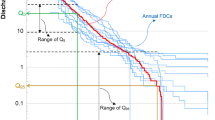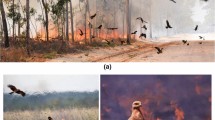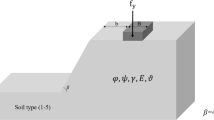Abstract
In present study, the comprehension of different types of bedforms generated by different bed roughness, in rectangular and circular cross-sectional rigid boundary channels and the resistance generated by the bed roughness against the flow are evaluated. Moreover, the critical condition of sediment motion under bed roughness influence is investigated. This study presents novel contributions in solving engineering problems that suffer from the lack of knowledge on the incipient motion of sediment particles in rigid boundary channels under bed roughness effects. Furthermore, soft computing and evolutionary computation methods have been combined to develop a new novel predictive model. The Evolutionary GENOFIS also aims at improving the ANFIS tool depends on Sugeno Fuzzy Inference System. The advantages of the proposed hybrid GENOFIS approach over the ANFIS tool is its novel ability to tackle the incipient prediction problem by using less fuzzy based rules and to represent the consequent part of the model as a constant, linear or non-linear function as well as with possible simultaneous combinations of them. For validation and comparison purposes, model performances of hybrid GENOFIS, ANFIS and data-based linear regression approaches are evaluated via experimental data partitioned for testing purposes. The model results are compared through corresponding RMSE and CE values. It is found that the hybrid GENOFIS model results outperformed the ANFIS and linear regression models. Consequently, novel experimental data-driven incipient motion formula and the hybrid GENOFIS approach are proposed to modeling complex incipient motion problems that are full of uncertainty and complication.








Similar content being viewed by others
Data Availability
All data and models that support the findings of this study are available from the corresponding author upon reasonable request.
References
Ackers JC, Butler D, and May RWP, (1996) Design of sewers to control sediment problems. Construction Industry Research and Information Association (CIRIA), Rep. No. 141, London, pp 1–181
Agudo JR, Dasilva S, Wierschem A (2014) How do neighbors affect incipient particle motion in laminar shear flow? Phys Fluids 26(5):053303
Agudo JR, Wierschem A (2012) Incipient motion of a single particle on regular substrates in laminar shear flow. Phys Fluids 24(9):093302
Ali M, Prasad R, Xiang Y, Deo RC (2020) Near real-time significant wave height forecasting with hybridized multiple linear regression algorithms. Renew Sustain Energy Rev 132:110003
Altunkaynak A (2013) Prediction of significant wave height using geno-multilayer perceptron. Ocean Eng 58:144–153
Altunkaynak A (2010) A predictive model for well loss using fuzzy logic approach. Hydrol Process 24(17):2400–2404
Altunkaynak A (2009) Sediment load prediction by genetic algorithms. Adv Eng Softw 40(9):928–934
Altunkaynak A (2008) Adaptive estimation of wave parameters by geno-Kalman filtering. Ocean Eng 35(11–12):1245–1251
Altunkaynak A, Elmazoghi HG (2016) Neuro-fuzzy models for prediction of breach formation time of embankment dams. J Intell Fuzzy Sys 31(3):1929–1940
Altunkaynak A, Kartal E (2019) Performance comparison of continuous wavelet-fuzzy and discrete wavelet-fuzzy models for water level predictions at northern and southern boundary of Bosphorus. Ocean Eng 186:106097
Altunkaynak A, Nigussie TA (2015) Prediction of daily rainfall by a hybrid wavelet-season-neuro technique. J Hydrol 529:287–301
Altunkaynak A, Wang KH (2012) Estimation of significant wave height in shallow lakes using the expert system techniques. Expert Syst Appl 39(3):2549–2559
Azamathulla HM, Ghani AA, Fei SY (2012) ANFIS-based approach for predicting sediment transport in clean sewer. Appl Soft Comput 12(3):1227–1230
Bizimana H, Altunkaynak A (2019) A novel approach for the prediction of the incipient motion of sediments under smooth, transitional and rough flow conditions using geno-fuzzy inference system model. J Hydrol 577:123952
Bizimana H, Yaqub M, Sönmez O, Eren B, Demir F (2016) Irrigation optimization by the use of fuzzy logic technology. Fresenius Environ Bull 25(1):325–336
Blott SJ, Pye K (2001) GRADISTAT: a grain size distribution and statistics package for the analysis of unconsolidated sediments. Earth Surf Proc Land 26(11):1237–1248
Bogardi JL (1965) European concepts of sediment transportation. J Hydraul Div 91(1):29–54
Bong CHJ, Lau TL, Ghani A (2013) Verification of equations for incipient motion studies for a rigid rectangular channel. Water Sci Technol 67(2):395–403
Buffington JM, Montgomery DR (1997) A systematic analysis of eight decades of incipient motion studies, with special reference to gravel-bedded rivers. Water Resour Res 33(8):1993–2029
Butler D, May R, Ackers J (2003) Self-cleansing sewer design based on sediment transport principles. J Hydraul Eng 129(4):276–282
Butler D, May RWP, and Ackers JC. (1996) Sediment transport in sewers. Pt. 1: background. Proc Inst Civil Eng Marit Energy 118(2):103–112
Charru F, Mouilleron H, Eiff O (2004) Erosion and deposition of particles on a bed sheared by a viscous flow. J Fluid Mech 519:55–80
Chiu, S, (1996) Method and software for extracting fuzzy classification rules by subtractive clustering. In Proceedings of North American Fuzzy Information Processing (pp. 461–465). IEEE
Choubin B, Khalighi-Sigaroodi S, Malekian A, Kişi Ö (2016) Multiple linear regression, multi-layer perceptron network and adaptive neuro-fuzzy inference system for forecasting precipitation based on large-scale climate signals. Hydrol Sci J 61(6):1001–1009
Crestani, F, Pasi, G, (Eds.) (2013) Soft computing in information retrieval: techniques and applications (Vol. 50). Physica
Dancey, C., and Diplas, P. (2013) Physics-based modeling of bridge foundation scour: numerical simulations and experiments. Virginia Polytechnic Inst And State Univ Blacksburg Office Of Sponsored Programs
Derksen JJ (2011) Simulations of granular bed erosion due to laminar shear flow near the critical shields number. Phys Fluids 23(11):113303
Deskos G, Diplas P (2018) Incipient motion of a non-cohesive particle under Stokes flow conditions. Int J Multiph Flow 99:151–161
Dey S, Ali SZ (2018) Advances in modeling of bed particle entrainment sheared by turbulent flow. Phys Fluids 30(6):061301
Diplas P, Dancey CL, Celik AO, Valyrakis M, Greer K, Akar T (2008) The role of impulse on the initiation of particle movement under turbulent flow conditions. Sci 322(5902):717–720. https://doi.org/10.1126/science.1158954
Donigian AS, Love JT (2003) (2003) Sediment calibration procedures and guidelines for watershed modeling. Proc Water Environ Fed 4:728–747
Duan JG, Barkdoll BD (2008) Surface-based fractional transport predictor: deterministic or stochastic. J Hydraul Eng 134(3):350–353
Einstein HA (1950) The bed-load function for sediment transportation in open channel flows. Technical Bulletin, United States Department of Agriculture, Soil Conservation Service, Washington, D.C.
El-Zaemey, AKS, (1991) Sediment transport over deposited beds in sewers (Doctoral dissertation, Newcastle University)
Elices MGGV, Guinea GV, Gomez J, Planas J (2002) The cohesive zone model: advantages, limitations and challenges. Eng Fract Mech 69(2):137–163
Everts C (1973) Particle overpassing on flat granular boundaries. J Waterways Harbors Coastal Eng Div 99(4):425–438
García S, Luengo J, Herrera F (2015) Data preprocessing in data mining. Springer International Publishing, Cham, Switzerland, pp 195–243
Grass AJ (1970) Initial instability of fine bed sand. J Hydraul Div 96(3):619–632
Helland-Hansen EA (1971) Time as a parameter in the study of incipient motion of gravel. Transaction of American Geophysics Union, Northwest Regional Section, Corvallis, Oregon, USA
Jang JS (1992) Neuro-fuzzy modeling: architectures, analyses, and applications. University of California, Berkeley
Jang JS (1993) ANFIS: adaptive-network-based fuzzy inference system. IEEE trans Sys Man Cybern 23(3):665–685
Kennard RW, Stone LA (1969) Computer-aided design of experiments. Technometrics 11(1):137–148. https://doi.org/10.1080/00401706.1969.10490666
Kitsikoudis V, Spiliotis M, Hrissanthou V (2016) Fuzzy regression analysis for sediment incipient motion under turbulent flow conditions. Environ Process 3(3):663–679
Kitsikoudis V, Sidiropoulos E, Hrissanthou V (2014) Machine learning utilization for bedload transport in gravel-bed rivers. Water Resour Manag 28(11):3727–3743
Kramer H (1935) Sand mixtures and sand movement in the fluvial model. Trans Am Soc Civil Eng 100(1):798–838
Lee H, Ha MY, Balachandar S (2012) Work-based criterion for particle motion and implication for turbulent bed-load transport. Phys Fluids 24(11):116604
Liu HK (1957) Mechanics of sediment-ripple formation. J Hydraul Div 83(2):1–23
Marsh NA, Western AW, Grayson RB (2004) Comparison of methods for predicting incipient motion for sand beds. J Hydraul Eng 130(7):616–621
Mamdani EH (1974) Application of fuzzy algorithms for simple dynamic plant. Proc IEEE 121:1585–1588
Mohammadi M (2005) The initiation of sediment motion in fixed bed channels. Iran J Sci Technol 29(B3):365–372
Montgomery, DC, Peck, EA, & Vining, GG (2012). Introduction to linear regression analysis (Vol. 821). Wiley
Moriasi DN, Arnold JG, Van Liew MW, Bingner RL, Harmel RD, Veith TL (2007) Model evaluation guidelines for systematic quantification of accuracy in watershed simulations. Trans ASABE 50(3):885–900
Nash JE, Sutcliffe JV (1970) River flow forecasting through conceptual models part I-A discussion of principles. J Hydrol 10(3):282–290
Nikuradse J (1933) Stromungsgesetze in Rauhen Rohren, Forschungshefte. VDI; NACA Tech Mem, 361, 1292. (Original in German)
Novak P, Nalluri C (1984) Incipient motion of sediment particles over fixed beds. J Hydraul Res 22(3):181–197
Ota JJ, (1999) Effect of particle size and gradation on sediment transport in storm sewers. PhD Thesis, University of Newcastle Upon Tyne, UK
Ota JJ, Perrusquia GS (2013) Particle velocity and sediment transport at the limit of deposition in sewers. Water Sci Technol 67(5):959–967
Özger M (2009) Comparison of fuzzy inference systems for streamflow prediction. Hydrol Sci J 54(2):261–273
Özger M, Şen Z (2007) Prediction of wave parameters by using fuzzy logic approach. Ocean Eng 34(3–4):460–469
Paintal AS (1971) Concept of critical shear stress in loose boundary open channels. J Hydraul Res 9(1):91–113
Papanicolaou AN, Diplas P, Evaggelopoulos N, Fotopoulos S (2002) Stochastic incipient motion criterion for spheres under various bed packing conditions. J Hydraul Eng 128(4):369–380
Paphitis D (2001) Sediment movement under unidirectional flows: an assessment of empirical threshold curves. Coast Eng 43(3–4):227–245
Patel PL, Ranga Raju KG (1999) Critical tractive stress of non-uniform sediments. J Hydraul Res 37(1):39–58
Safari MJS, Aksoy H, Unal NE, Mohammadi M (2017) Experimental analysis of sediment incipient motion in rigid boundary open channels. Environ Fluid Mech 17(6):1281–1298
Safari, MJS, (2016) Self-cleansing drainage system design by incipient motion and incipient deposition-based models. PhD Thesis, Istanbul Technical Univesity
Salem, AM, (2013) The effects of the sediment bed thickness on the incipient motion of particles in a rigid rectangular channel. In Proc. 17th Int Water Technol Conf, IWTC17, Istanbul, Turkey
Sentürk F (1969) Mechanics of bed informations. La Houille Blanche 2:163–172
Senturk F (1987) Incidents and failures of hydraulic structures subject to independent floods. In Engineering Reliability and Risk in Water Resources, Springer, Dordrecht
Şentürk, F, (1994) Hydraulics of dams and reservoirs. Water Resources Publication
Shields, A, 1(936) Anwendung der aehnlichkeitsmechanik und der turbulenz- forschung auf die eschiebebewegung. Mitteilungen der Preussiischen versuch- sanstalt fur wasserbau und schiffhau, Heft 26, Berlin. [English Translation by W.P. Ott and J. C. van Uchelen, Publication No. 167. Hydrodynamics Lab., Califor- nia Inst. of Technology, Pasadena, CA, 1950]
Simons, DB, Richardson, EV, (1966) Resistance to flow in alluvial channels. US Government Printing Office
Simons, DB, & Şentürk, F, (1992) Sediment transport technology: water and sediment dynamics. Water Resources Publication.
Sipiliotis M, Kitsikoudis V, Kirca VO, Hrissanthou V (2018) Fuzzy threshold for the initiation of sediment motion. Appl Soft Comput 72:312–320
Solomatine DP, Dulal KN (2003) Model trees as an alternative to neural networks in rainfall-runoff modelling. Hydrol Sci J 48(3):399–411
Sugeno M (1985) An introductory survey of fuzzy control. Inf Sci 36(1–2):59–83
Suparta, W, Alhasa, KM, (2013). A comparison of ANFIS and MLP models for the prediction of precipitable water vapor, 2013 IEEE Int Conf on Space Sci Commun (IconSpace), Melaka, 2013, pp. 243–248, https://doi.org/10.1109/IconSpace.2013.6599473
Tison, LJ, (1953) Studies of the critical tractive force of entrainment of bed materials. In Proc: Minnesota Int Hydraul Convention (pp. 21–36). ASCE
Uyumaz A, Altunkaynak A, Özger M (2006) Fuzzy logic model for equilibrium scour downstream of a dam’s vertical gate. J Hydraul Eng 132(10):1069–1075
Valyrakis M, Diplas P, Dancey CL, Greer K, Celik AO (2010) Role of instantaneous force magnitude and duration on particle entrainment. J Geophys Res. https://doi.org/10.1029/2008JF001247
Vanoni, VA, (1964) Measurements of critical shear stress for entraining fine sediments in a boundary Layer. Report KH-R-7. WM, Keck, Laboratory of Hydraulics and Water Resources, Division of Engineering and Applied Science, California Institute of Technology, Pasadena, California
White SJ (1970) Plane bed threshold of fine-grained sediments. Nature 228:152–153
Wu FC, Chou YJ (2003) Rolling and lifting probabilities for sediment entrainment. J Hydraul Eng 129(2):110–119
Wu FC, Yang KH (2004) Entrainment probabilities of mixed-size sediment incorporating near-bed coherent flow structures. J Hydraul Eng 130(12):1187–1197
Yalin MS, Da Silva AMF (2001) Fluvial processes. IAHR monograph, International Association for Hydraulic Research, Delft
Yalin MS, Karahan E (1979) Inception of sediment transport. J Hydraul Div 105(11):1433–1443
Zadeh, L. A. (1996) Fuzzy logic, neural networks, and soft computing. In Fuzzy sets, fuzzy logic, and fuzzy systems: selected papers by Lotfi A Zadeh
Zounemat-Kermani M, Meymand AM, Ahmadipour M (2018) Estimating incipient motion velocity of bed sediments using different data-driven methods. Appl Soft Comput 69:165–176
Author information
Authors and Affiliations
Corresponding author
Ethics declarations
Conflict of interest
The author declare that no conflict of interest.
Additional information
Publisher's Note
Springer Nature remains neutral with regard to jurisdictional claims in published maps and institutional affiliations.
Rights and permissions
About this article
Cite this article
Bizimana, H., Altunkaynak, A. Investigating the Effects of Bed Roughness on Incipient Motion in Rigid Boundary Channels with Developed Hybrid Geno-Fuzzy versus Neuro-Fuzzy Models. Geotech Geol Eng 39, 3171–3191 (2021). https://doi.org/10.1007/s10706-021-01686-2
Received:
Accepted:
Published:
Issue Date:
DOI: https://doi.org/10.1007/s10706-021-01686-2




